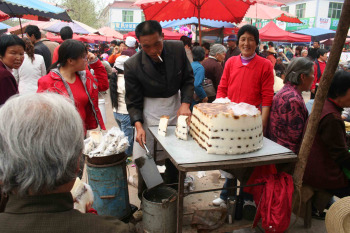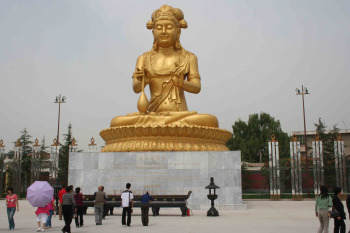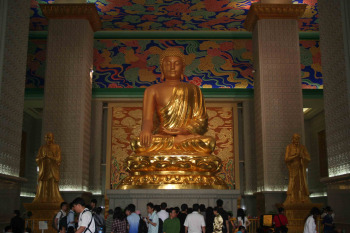
 At first glance, one might think this Buddhist shrine belongs in a science-fiction movie. Or somewhere in Las Vegas.
At first glance, one might think this Buddhist shrine belongs in a science-fiction movie. Or somewhere in Las Vegas.
I approached it from almost a mile away, unsure if I should feel blessed or intimidated. It was, after all, the world’s highest stupa according to local media reports.
Built to resemble two giant hands in prayer, the shrine is part of the latest transformation at one of China’s most renowned Buddhist temples.
My trip to this place began as I left Xi’an, a major city in central China. Taking a tourist bus from the train station, I traveled 70 miles west, toward Famen Temple, which has stood for more than 1,500 years. But it’s only been recently that the place has undergone a facelift of sorts, in which a new addition to the temple was unveiled this year.
The highlight of this expansion is the massive stupa that seems to loom over the area. Called Palms Together Dagoba, 合十舍利塔, it reaches almost 500 feet high, and is surrounded by what seems to be a palace-worth of Buddhist imagery.

 Leading up to the stupa is a long path that stretches for more than half a mile. Golden Bodhisattvas flank the walkway on both sides, inspiring worshipers to stop and pray with their incense sticks. Along the way are exhibits detailing Buddhism history and culture. “Current happiness and sufferings are not always caused by karmas in this life,” one sign read in English.
Leading up to the stupa is a long path that stretches for more than half a mile. Golden Bodhisattvas flank the walkway on both sides, inspiring worshipers to stop and pray with their incense sticks. Along the way are exhibits detailing Buddhism history and culture. “Current happiness and sufferings are not always caused by karmas in this life,” one sign read in English.
I entered this place with little knowledge of the religion, watching as if I were totally foreign to the dozens of people who came to pay their respects. But one does certainly feel that being here is akin to walking a symbolic path toward Nirvana. The pavement road is like a grey cloud in heaven. The giant statues sit solemnly as if they were meditating gods. And the Palms Together Dagoba at the end represents enlightenment.
Stupas, which are also known as dagobas, are Buddhist structures that contain ancient relics. Often they are old, and generally look like large mounds.
As for Palms Together Dagoba, it seems to have an almost futuristic veneer at times. But it does house a very historic Buddhist relic: an actual finger bone to Siddhartha Gautama, the founder of the religion. Palms Together Dagoba was built to protect and better consecrate this Buddhist relic. The finger bone is kept underground in a sanctum.

 Nearby is the actual Famen Temple and where the finger bone relic was originally stored for hundreds of years. Standing in the middle of the temple is a large stone pagoda, which was rebuilt after it had collapsed apart.
Nearby is the actual Famen Temple and where the finger bone relic was originally stored for hundreds of years. Standing in the middle of the temple is a large stone pagoda, which was rebuilt after it had collapsed apart.
Temple monks, dressed in their simple robes, watched as the visitors knelt and prayed. “Don’t take photos,” one of them yelled as I tried to snap a photo of a sacred area.
Tributes to Buddhism prevail throughout the area. But to non-believers like me, the real treat in visiting the area was the local town that sits outside the temple gates.
While there, I shuffled my way through a vast street market flooded with local people. A few merchants sold giant Chinese cakes, cleaving off a slice to any buyer. Here in the market the food is cheap, but the seating is crowded, where people squat on small stools and eat on foldable tables.
During lunch time I found myself comfortably eating alone in a clean, but vacant restaurant, paying for a rather expensive meal; (if only I had chosen to dine in the market’s local shops.) Choosing to go with the restaurant owner’s recommendation, I had myself two of the greenest and most leafiest dishes I’ve ever had, no doubt influenced by the Buddhist atmosphere.
There were other sights in the market as well: a goat being pulled along by its owner; street side fortune tellers with no customers; young people playing billiards on pool tables outside; a man selling live turtles. For pets, or for food, I don’t know; but I hope it’s the former.

 I also had a chance to walk around some of the local neighborhoods. Most of the buildings were made out of brick and painted yellow. Government signs promoting proper behaviors were also posted on the power poles. “Whether it’s a boy or a girl, they are both the same. Of the most importance is population quality,” one sign read.
I also had a chance to walk around some of the local neighborhoods. Most of the buildings were made out of brick and painted yellow. Government signs promoting proper behaviors were also posted on the power poles. “Whether it’s a boy or a girl, they are both the same. Of the most importance is population quality,” one sign read.
I returned back to the temple, ready to head back Xi’an. Outside one of the temple walls, a thick strip of black ash had piled up. Local people were burning paper and fake money to honor their ancestors. From what I could tell, on the faded green paper they burnt, people would write the names of relatives who had passed away. Now in retrospect I wish I could have burned some paper as well. I’ll have to do it another time.